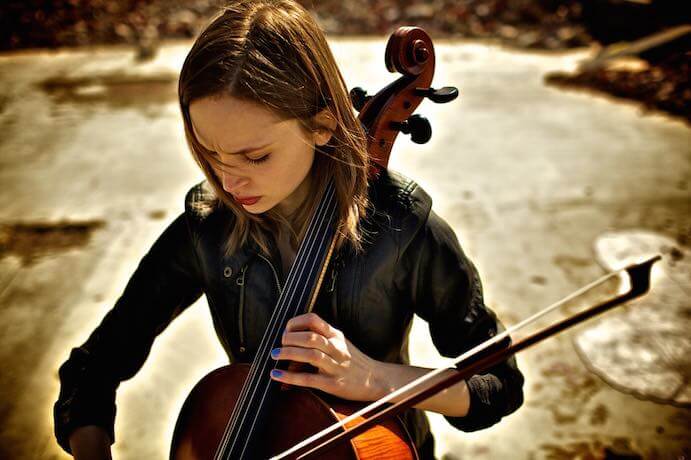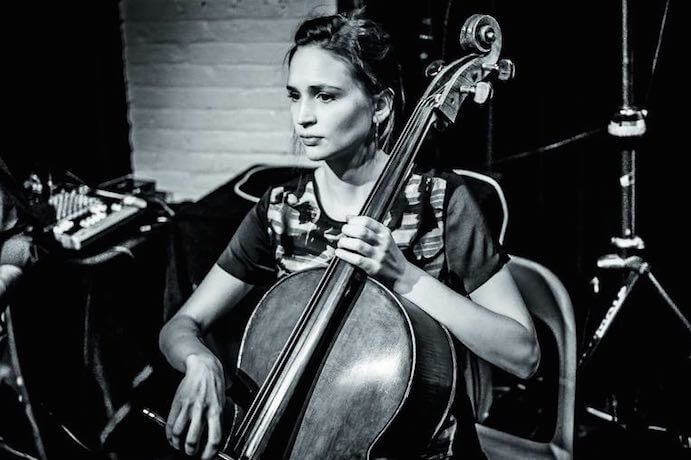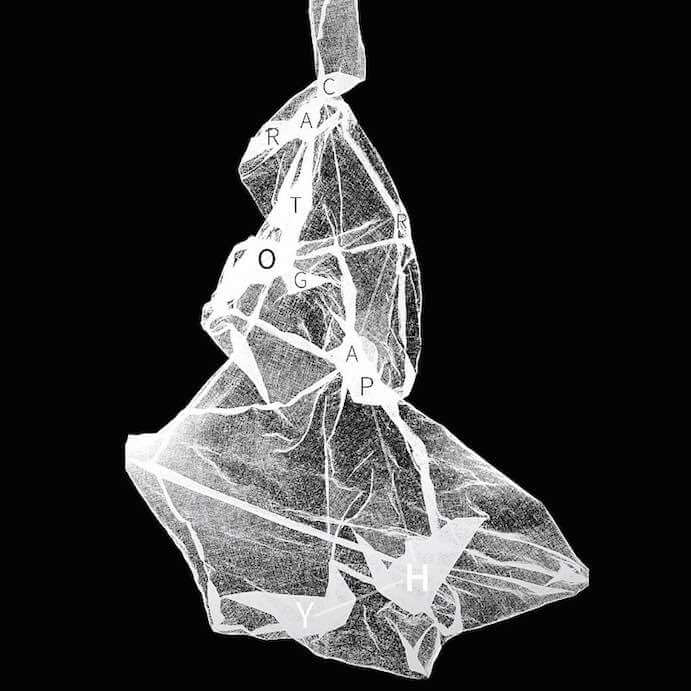The monochromatic cover art of Mariel Roberts’ Cartography is cryptic and arresting: a figure struggling in a woven cocoon hangs in darkness, the album’s title cascading down its folds letter by letter. Jessica Slaven’s inked drawing captures the dangerous and intoxicating world of Cartography, Roberts’ second solo album out now on New Focus Recordings. In its four dark and vulnerable pieces, Roberts casts a powerful and delicate web, connecting the shadowy cracks in the rich palette of the cello.
The album opens with the standout piece, Eric Wubbels’ manic gretchen am spinnrade for cello and piano. From the rhythm of the cello’s repeated notes to the piano’s corrupted arpeggios, there are distant echoes of the piece’s namesake. In Franz Schubert’s song, Gretchen struggles to restart the spinning wheel before the final refrain, while the wheel in Wubbels’ work often gets caught in “idling motion” – a mechanically-precise riff repeats many times, hammer and bow ricocheting across strings asymmetrically like a lopsided bobbin unspooling. In an ecstatic moment late in the piece, Wubbels trills a single note in the lowest octave, and Roberts emerges from its dense tangle of harmonics with a patiently repeating motive, which leads the piano back into a clacking, staccato polyphony. This kind of interplay throughout the piece creates the “turning of cause and effect” Wubbels references in his program note.
Cenk Ergün’s Aman uses live electronics to obscure the cello’s identity, creating an uncanny sonic world. The piece begins with noisy cello artifacts, taps and scrapes on the instrument which slowly build into a pointillistic blizzard. Eventually, an insistent plucked string sounds, ringing bright like a guitar. Low notes groan, sinister in their quiet and unstable grating, while pizzicato notes and articulated bursts of noise recall the early synthesized music of Morton Subotnick. The piece abruptly ends after teasing a return to this chaos from a series of long, warmly detuned notes. Aman succeeds on Roberts’ assertive navigation of its somewhat aimless form, with its sudden changes in timbre and energy (the title, notes Ergün, means something like “watch out!” in Turkish).

Mariel Roberts
Roberts commissioned and premiered George Lewis’ Spinner for solo cello, which is inspired by Clotho, the Fate of Greek myth who determines the length of each human’s life by spinning a length of thread. In this showcase of Roberts’ technical and interpretive mastery, the moments of fierce passagework suddenly give way to hesitating harmonics, scratchy tremolos, or impish pizzicato, perhaps representing many entangled individual lives meted out on the strings of the cello. Like much of George Lewis’ music, Spinner is at once deadly serious and irreverent.
Davíð Brynjar Franzson quotes Ludwig Wittgenstein in his program note to The Cartography of Time: “How is it possible that one should measure time? For the past cannot be measured, as it is gone by; and the future can’t be measured because it has not yet come. And the present can’t be measured for it has no extension.” The act of listening is to create a map of time, surveying the the past and future simultaneously, observing the topography and orientation of the musical terrain from the vantage point of the infinitesimal present. Franzson has written several versions of the piece for other instruments and ensembles, but the rhetorical power of a solo instrument–especially one as muscular and fragile as the cello–makes Roberts’ interpretation a standout among them.

Mariel Roberts
Beginning with a ghostly rasping of bow hair on string, Roberts’ cello rings a low, resonant pitch, evaporating into a sustained, ethereal harmonic. Subtle live electronics granulate the instrument’s sound and nervously jostle it around the stereo field, creating a spiky texture on top of the glacial harmony and blurring the causality of interactions between instrument and electronics. It’s not until a third of the way through the spacious 20-minute piece that other pitches enter this spare world, spinning out on delicate threads that dissipate at different rates. But the tectonic low pitch from the beginning has never really gone away, even when we only hear it resonating in harmonic tremors on the surface.
This is the most essential map of music: a single pitch’s resonance, its infinite spectrum unfolding across time. Like a cartographer peels and flattens the globe, distorting its poles so we can navigate the rhumb lines, music projects the many dimensions of the ineffable onto our linear experience of time. With the album’s consistent thematic unity, flawless production, and thoughtful performance, Mariel Roberts is both an expert mapmaker and navigator on Cartography.























